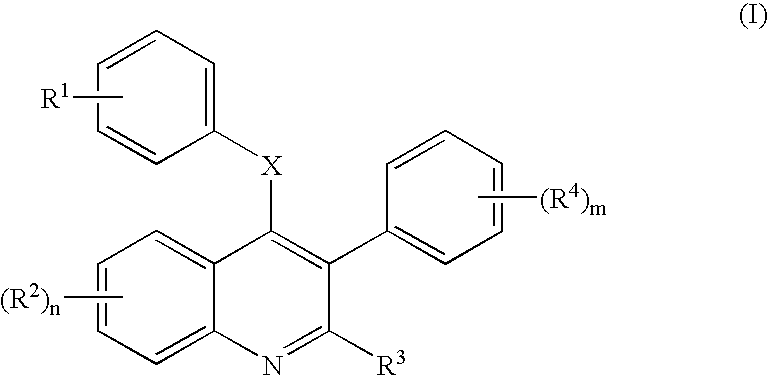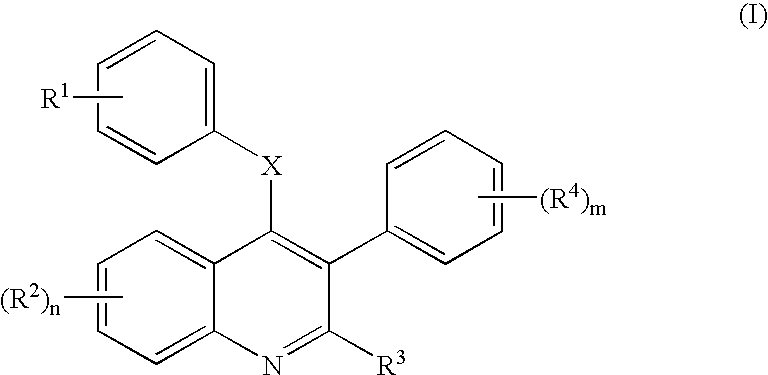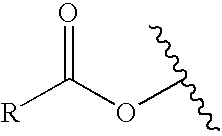Substituted Quinoline Compounds For Use As Selective Estrogen Receptor Modulator
a technology of selective estrogen receptor and quinoline, which is applied in the field of substituting quinoline compounds, can solve the problems of increasing the economic burden of osteoporotic fractures, and increasing so as to reduce the risk of fractures, and increase the economic burden of fractures
- Summary
- Abstract
- Description
- Claims
- Application Information
AI Technical Summary
Benefits of technology
Problems solved by technology
Method used
Image
Examples
example 1
[0103]
4-[(7-Hydroxy-2-ethyl-3-phenyl-4-quinolinyl)oxyphenyl]-2-propenoic acid (6a; R2=7-OH, R3=Et, R4=H in Scheme 1)
A. 3-Phenyl-4-hydroxy-7-methoxyquinol-2-one (2a)
[0104] A dark solution of 3-anisidine (5.37 g, 44.8 mmol), diethyl 2-phenylmalonate (10.57 g, 44.8 mmol), and diphenyl ether (50 mL) was heated at 220° C. for 1 h without a reflux condenser to allow ethanol evaporation. The reaction was cooled to rt, and the resultant gray precipitate filtered and washed with diethyl ether and dried to afford 11.0 g 2a (R2=7-OMe in Scheme 1, 92% yield): MS (M+H)+ 269.28.
B. 2,4-Dichoro-3-phenyl-7-methoxyquinoline (3a)
[0105] A slurry of 2a (7.0 g, 26.2 mmol) and phosphorous oxychloride (30 mL) was heated at 110° C. for 2 h, cooled to rt, and stored in the refrigerator for 1 h. The resultant mixture was slowly decanted into ice cold 10% potassium carbonate (50 mL) to furnish a white precipitate. The ppt was filtered and partitioned between 10% potassium carbonate (100 mL) and EtOAc (150 ...
example 2
[0110]
4-[(7-Hydroxy-2-ethyl-3-phenyl-4-quinolinyl)oxyphenyl]-2-propenoamide (8a, Example 2)
[0111] A CEM microwave tube was charged with 7 (0.040 g, 0.095 mmol), triphenylphosphine (0.0137 g, 0.045 mmol), palladium acetate (0.005 g, 0.024 mmol), acrylamide (0.032 g, 0.46 mmol) and triethylamine (0.0387 mL, 0.29 mmol) in ACN (2 mL). The reaction was subjected to microwaves (150 w, 30 min 175° C.). The reaction was filtered, evaporated and poured into water (3 mL) and extracted with EtOAc (3×5 ml). The combined organic layer was washed with brine (5 mL) and dried over MgSO4, and evaporated. The crude solid was purified via high pressure liquid chromatography (HPLC; ACN / H2O) to afford 0.021 g (54% yield) of a yellow solid. 1H NMR (300 MHz, CD3OD): δ7.75-7.72 (d, 1H), 7.40-7.29 (m, 7H), 7.22-7.18 (m, 2H), 7.12-7.08 (dd, 2H), 6.65-6.62 (d, 2H), 6.49-6.44 (d, 1H), 2.82-2.75 (q, 2H), 1.18-1.13 (t, 3H). MS (M+H)+ 411.16. C26H22N2O3.
example 3
[0112]
4-[(7-Hydroxy-2-ethyl-3-phenyl-4-quinolinyl)oxyphenyl]-2-propeno-N-isopropylamide (Example 3)
[0113] Example 3 (0.0253 g) was prepared as described for Example 2: LC / MS rt 4.19 min (Conditions I); MS (M+H)+ 453.55. C29H28N2O3.
PUM
| Property | Measurement | Unit |
|---|---|---|
| Temperature | aaaaa | aaaaa |
| Temperature | aaaaa | aaaaa |
| Temperature | aaaaa | aaaaa |
Abstract
Description
Claims
Application Information
 Login to View More
Login to View More - R&D
- Intellectual Property
- Life Sciences
- Materials
- Tech Scout
- Unparalleled Data Quality
- Higher Quality Content
- 60% Fewer Hallucinations
Browse by: Latest US Patents, China's latest patents, Technical Efficacy Thesaurus, Application Domain, Technology Topic, Popular Technical Reports.
© 2025 PatSnap. All rights reserved.Legal|Privacy policy|Modern Slavery Act Transparency Statement|Sitemap|About US| Contact US: help@patsnap.com



